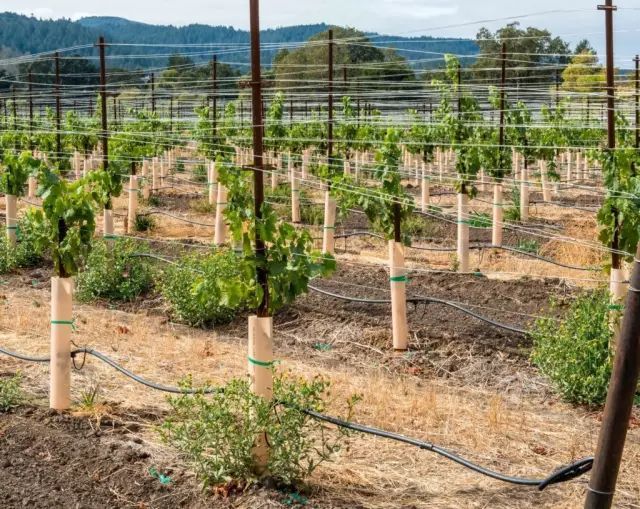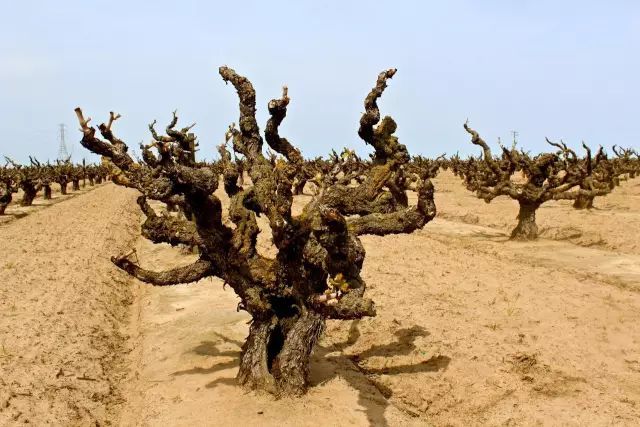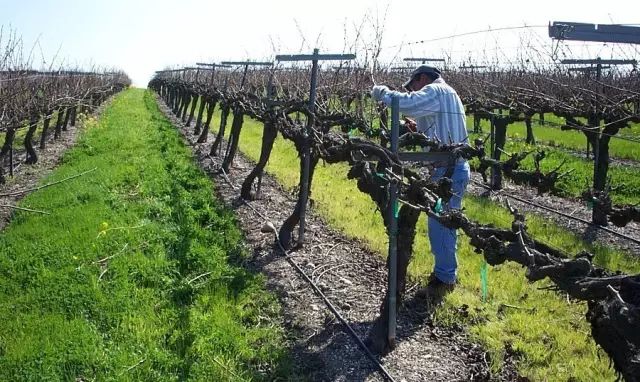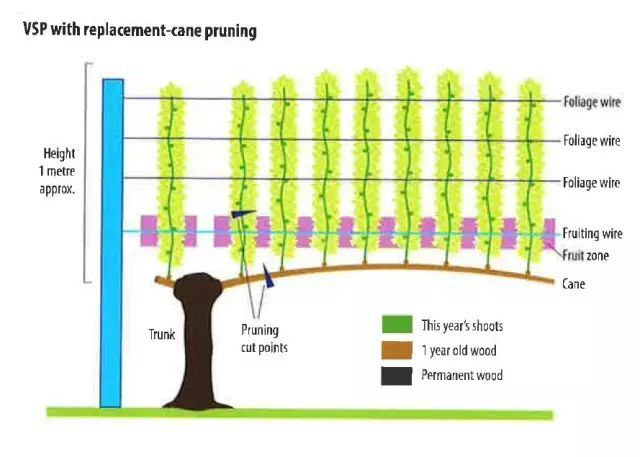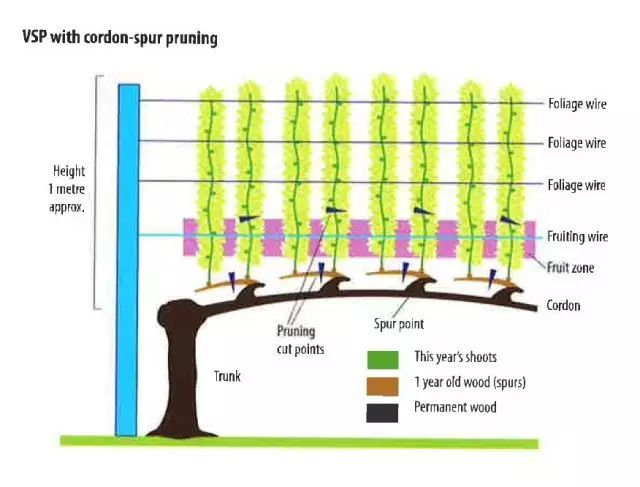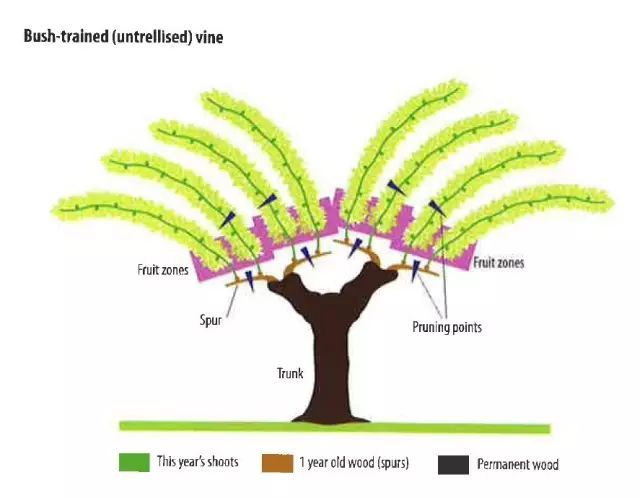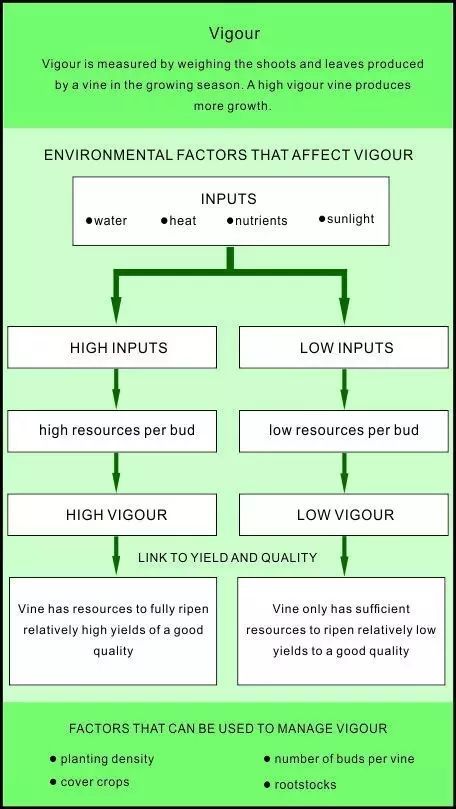2017-02-23 WSET 3 葡萄酒的门徒
3 葡萄园地管理
The viticulturalist applies their understanding of how the environment affects the vine’s growth. First a site needs to be selected and matched with a suitable grape variety. The most suitable trellising, training and pruning system needs be selected and installed before the vineyard is finally planted. Once the vines are established the viticulturalist must oversee the annual cycle of pruning, pest and diseasemanagement and harvest. Their decisions affect the quality and quantity of fruit that is successfully harvested each year.
葡萄种植者了解环境如何影响葡萄的生长,并将其应用到葡萄种植的实践中。首先,要选择葡萄园位置以及相应合适的葡萄品种,在葡萄最终定植之前,就选好最适合栽培架势,整形以及修剪方式。一旦葡萄定植之后,种植者每年必须做好修剪,虫害,病害以及采收的管理。他们的决定会影响到每年丰收葡萄的品质和产量。
SITE SELECTION
When a producer wants to establish a new vineyard the potential site needs to be assessed for its environmental and practical suitability. Suitable grape varieties will need to be chosen.
位置的选择
当种植者准备建造一个新葡萄园时,是需要根据周边环境和可操作性来评估某个选址是否合适。同时还需要选择适宜的葡萄品种。
Environmental conditions: The viticulturalist can use data to work out the potential site’s average temperature, rainfall and sunlight hours as well as the fertility of the soil and how well drained it is. These factors will influence the choice of grape variety as well as the ideal planting density, and systems of training and trellising.
环境条件:葡萄种植者可以通过数据测算出某个选址的平均温度、降雨量、日照时间,土壤肥力以及排水能力。这些因素将会影响到葡萄品种、最佳种植密度、整形以及栽培架式的选择。
Business considerations: How close a vineyard is to the utility infrastructure (power, water, etc.), a vineyard workforce and how easy it is to access with machinery, such as tractor and harvesters, are all important considerations in the financial viability of a site.
商业考虑:葡萄园离公共基础设施(电力、水资源等)以及园内劳动力情况的远近程度,机械设备(如拖拉机和收割机)的可用性:这些都是选址在财务可行性上需要慎重考虑的因素。
Grape variety: The grape variety must suit the climatic conditions of the preferred site. There must also be a demand for the grapes. In EU vineyard areas there may also be legal restrictions on the varieties that a producer can use.
葡萄品种:葡萄品种必须适应选定的位置的气候条件。这也是对葡萄品种一个要求。在欧盟,很多葡萄园所在的地区可能还对种植者可以使用的葡萄品种有一些法律限制。
PLANTING
Once a new vineyard site has been cleared of any existing vegetation, the soil’s drainage and fertility can be improved. The soil is then ploughed to a fine tilth to prepare for planting the vines.
种植
新的葡萄园位置选定后,先要清除原先园地里的植物,才能够提高土壤的排水性和肥力。土壤接下来会被耕犁到适合耕作的状况,为接下来的葡萄种植做好准备。
Most viticulturalists purchase vines from a plant nursery, but some may purchase cuttings from a neighbour, and arrange for these to be grafted. The advantage of using nursery material is that clones with known characteristics can be purchased, and the plants can be certified to be free of virus infections. Many regions have strict quarantine processes, to prevent the spread of pests and diseases. This can limit the choice of varieties and clones that are available.
大多数的葡萄栽培者会从苗圃购买幼苗,但是也有一些人会从相邻葡萄园购买可供扦插的枝条,再用这些枝条进行嫁接。使用苗圃幼苗的优势在于可以购买到有可靠特征的品系,以及可以确保幼苗没有感染任何病毒。很多地区都有非常严格的检疫措施,从而避免虫害和病害的传播。这些措施会限制可供使用的品种和无性繁殖种的选择。
Vines are usually planted pre-grafted, although in exceptionally dry conditions, the rootstock may be planted first, to see if it can establish itself, before the scion is grafted in the vineyard. Once planted, the young vines are usually protected against weedsby covering the land around the vines with a suitable mulch, and against animals by sheathing the vines with individual plastic sleeves. They will usually be irrigated while they develop their root system. The first yield normally comes in the third year after planting.
通常葡萄植株在种植前都已经经过嫁接,不过在干旱条件下也有例外,这时会提前种植砧木,在砧木定植后,才将接穗嫁接到它的上面。一旦定植后,幼苗周围的土地会被铺上覆盖物以遏止杂草的生长,并对每一棵葡萄苗使用单独的塑料套管从而避免受到动物的伤害。通常当幼苗长出它们的根系之后才进行浇灌,三年后才会出此结果。
Although they can be very long lived, most vines are replaced between the ages of 30 and 50. Some old vines produce fruit of exceptional quality, although the quantity of fruit decreases with age. Abalance has to be struck between quality and profitability. A vineyard owner will have a replanting cycle that ensures that as little of their vineyard as possible is out of production at any one time. Normally, vineyard land is left fallow for three years or more after the vines are dug up so that it can recover.
尽管可以存活很多年,但是大多数的葡萄树会在30年到50年后被替换掉。一些古老的葡萄树也可以结出品质超群的果实,不过随着树龄的增长产量会逐渐降低。为了在高品质和丰产性之间取得平衡,葡萄种植者会制订出一个重植的周期,以确保葡萄园在任何时期处于停产状态的葡萄数量尽可能地少。一般情况下,挖出葡萄树后,葡萄园的土地需要休耕三年或是更长时间来恢复地力。
MANAGING THE VINE
Left to nature, vines will produce crops of grapes that are ripe enough to be attractive to birds, but not ripe enough to be suitable for winemaking. They will also tend to put their resources into growing the plant, rather than ripening fruit. The viticulturalist needs to control the vigour of the vine to encourage larger quantities of riper fruit. The options for achieving this include selecting appropriate planting density, pruning and trellising. The viticulturalist then needs to control the potential quality and ripeness of these grapes. This can be achieved by training and canopy management.
葡萄树的管理
完全自然生长条件下,葡萄树可以结出那些成熟度足以吸引鸟类的果实,但是这种成熟度对于酿酒而言是远远不够的。同时葡萄树会倾向于将资源用作植株生长,而不是促进葡萄果实的成熟。葡萄种植者需要对树势进行管理来促进大量果实的成熟。达到这一目的的措施包括:选择合适的种植密度,适宜的修剪方式和栽培架式。葡萄种植者需要控制葡萄的潜在品质以及成熟度。这些目的都可以通过整形以及树冠管理来达到。
A vine unstressed by disease and nutrient or water deficiency can grow vigorously and reach a substantial size, which is completely impractical for commercial viticulture. Therefore, for practicalpurposes, the size of vines needs to be controlled. Before discussing vine management strategies more broadly it is necessary to discuss the techniques that are used to manage a vine’s size and shape. In the following section it is important to distinguish the following terms:
一棵没有得过病,不缺少养分或水分的葡萄树会生长得极为旺盛并且长得非常高大,然而过于高大对商业化栽培来说是完全不实用的。因此,为了更为实用,需要控制葡萄树的大小。在全面地讨论葡萄树管理措施之前,有必要先探讨用于管理葡萄树的大小以及形状的技术。在接下来的章节中,区分下面的这些术语非常重要。
Trellis –This consists of the permanent structure of stakes and wires that are present in a vineyard. This can vary from nothing to hugely complex multi-wire systems.
栽培架式 — 由葡萄园中永久固定的支柱和金属丝组成。栽培架式可以无架式,也可以极其复杂到使用多金属丝系统。
Training – The vine’s permanentwood and canes are trained to follow the trellising system that has been established. If there is no trellising system the vine shoots will grow unsupported.
整形 — 葡萄树的多年生枝条和长枝(结果母蔓)都需要根据已经建立的栽培架式进行整形。如果没有栽培架式,葡萄树的新枝生长会缺少支撑物。
Pruning – This is the removal of unwanted leaves, canes and permanent wood either in the winter or during the growing season.
修剪 — 指在冬季或是生长季内,去除掉葡萄不需要的叶片、长枝(结果母蔓)以及多年生枝条。
Winter and Summer Pruning
The main purpose of winter pruning is to determine the number and location of buds, which will form shoots for the production of fruit in the coming harvest. There are two types of winter pruning:
冬季修剪和夏季修剪
冬季修剪的主要目的是选择留下过冬的芽的位置以及数量,正是这些牙会在来春发育长成新枝,进而在下一个收获季提供果实。冬季修剪有两种方式:
Replacement cane pruning: One, or more, canes are retained. The remaining canes will be trained horizontally onto the trellis. It is a system that cannot be easily mechanised and requires a large skilled workforce. This pruning system is often referred to as Guyot. One cane is retained in Single Guyot; two is double Guyot.
替换长枝(结果母蔓)的修剪:保留一枝或是更多的长枝(结果母蔓)。留下的长枝通过整形与栽培架式平行。这个过程不能简单地使用机械来操作,需要耗费大量的技术熟练的劳动力。这种修剪方式通常被称做Guyot居由式。如果只保留一根长枝就是单居由式(Single Guyot),保留两根就是双居由式(Double Guyot)。
Spur pruning:A larger number of two to three bud spurs are retained. These are either distributed along a permanent cordon of old wood, which is trained horizontally along the trellis, or around the head of a vine. Vines with a permanent cordon can be mechanically pruned, leading to a significant cost saving.Permanent wood is also less susceptible than canes to frost damage.
短枝修剪:保留大量有两到三个芽的短枝。这些短枝要么分布在通过整形与栽培架式平行的多年生枝条的主蔓上,要么就分布在葡萄树的顶部周围。那些多年生的主蔓可以用机器修剪,这样能够节省一笔很可观的开支。多年生枝条与长枝相比更耐冻害。
Summer pruning involves trimming the canopy to restrict vegetative growth and direct sugar production to the grape, rather than the growth of shoots and leaves. It can also involve leaf stripping so that bunches of grapes have optimum exposure to sunshine.
夏季修剪包括对树冠进行修剪,控制枝叶生长,以避免新枝和叶片过多生长,从而促进葡萄果实中糖分的生产。夏季修剪还包括叶片的清理,以保证葡萄果串可以享受到最充足的阳光照射。
Training and Trellising
Pruning limits the size of the vine whereas training is designed to manage the direction of growth of the following season’s shoots. The positioning of these shoots is important because it affects the amount of sunlight that is intercepted by the leaves, and also the location and exposure of the fruit that grows at the base of each shoot.
整形和栽培架式
通过修剪可以控制葡萄树的大小。而通过整形可以控制生长季内新梢的生长方向。这些新梢的位置非常重要,因为它们决定了将来叶片阻挡阳光的程度,并且影响到生长在新梢底端的果实的位置以及果实接收到的阳光强度。
Training and trellising systems can, broadly, be put into three groups:
Bush trained: The permanent wood consists of a vertical stump, which is pruned to retain a number of spurs distributed around the head of the vine. The shoots that grow from these spurs are often untrellised, and sprawl across the ground. This system is practical in hot, dry and sunny regions such as the Southern Rhône and the Barossa Valley. In cool or wet regions, the shade can impede grape ripening and the lack of airflow can limit evaporation and promote disease. This is avoided in Beaujolais where the shoots of bush trained vines are tied together at the tips, which helps expose bunches to air and sunlight.This system is not suitable for mechanical harvesting. This training system is sometimes referred to as gobelet.
整形和栽培架式大致可以分成三类:
灌木形(杯型):多年生的枝条由垂直的根株组成,这些根株的顶端周围分布着一定数量的修剪过的短枝。由这些短枝长出来的新枝通常不会依附在架式上,而会在地面上蔓延开来。这样的修剪方式在炎热、干燥且光照充足的地区非常实用,例如南罗纳河谷和巴罗萨山谷。在凉爽或潮湿的地区,葡萄的树荫会阻碍果实的成熟,而通风不畅会减少蒸腾量,并滋生病害。在博若莱地区,人们会将修剪成灌木式树形上的新枝的顶端绑在一起,这样会改善葡萄果串的通风与光照情况,进而避免上述的问题。这种整形方式不适合用机械采收。有时候这种整形方式也被称为杯形(gobelet)。
Vertical shoot positioning (VSP):This is the most common training system worldwide, and may be used with replacement-cane or cordon-spur pruning. There is a single canopy consisting of shoots that are trained upwards, vertically from their cane or cordon and are tied in place onto the trellis. This canopy may extend both sides of the vine’s trunk, or may be limited to one side. From the trunk, the cane(s) or cordon(s) are trained horizontally, although canes may be bent onto a horizontal arch. The cane(s) or cordon(s) may be low trained, to benefit from heat retained by the earth, or high trained, to avoid frosts.The shoots are then trained vertically. By keeping the shoots apart this system keeps the canopy as well aerated and shade free as possible. VSP is most suitable for conditions where vines are planted to a high density.
新枝垂直分布形(Vertical shoot positioning,简称为VSP):这是全世界最通用的一种树形,还会与长枝(结果母蔓)的替换修剪或是主蔓 - 短枝修剪配合使用。它有一个单一树冠,该树冠由被整形成向上状态的新枝组成,这些新枝与它们着生的长枝或主蔓垂直,并被绑在栽培架势上。这个树冠可能会将葡萄树主干向两边延展,也可能只向一边延展。在主干上,长枝或是主蔓都以水平方向整形,尽管长枝有时候会被弯成水平拱形。结果母蔓和主蔓可以被压得很低,这样它们就能够获得地面残留的余热,也可以被抬得很高进而避免霜冻的伤害。之后,新枝就会被整形成垂直状态。通过保持各新枝间的分离状态,这种整形方式可以最大程度地保证树冠通气良好,并且尽可能的没有树荫。VSP在种植密度很高的情况下是最合适的整形方式。
Big vines: Where vines are planted to lower densities, systems have been developed to balance vine vigour and ensure best use is made of the available light. Some use a single vine canopy (like VSP), but split the canopy vertically, with some shoots trained downwards. Others have multiple canopies running parallel to each other and linked to the same trunk. These ‘big vine’systems can have complicated vine geometries and require a lot of permanent wood. Examples include Lyre and Geneva Double Curtain.These systems are usually spur pruned and many are suitable for mechanical harvesting. Pergola systems can be regarded as ‘big vines’, though they are designed to allow additional crops underneath the vines, rather than balancing vine vigour.
大葡萄树形:如果葡萄树的种植密度偏低,整形方式就要与葡萄树的树势之间有一个很好的平衡关系,从而保证能最高效率地利用光照。有些是只保留一个单树冠(比如VSP),但是将树冠上下分开,并且有一些新枝被压成向下生长的状态。另一些是多树冠形,各树冠之间呈平行状态,并且连在相同的主干上。这样的大葡萄树形有着非常复杂的几何结构,也需要许多的多年生枝条才能构成。例如七弦竖琴式(Lyre)和日内瓦双帘式(Geneva Double Curtain)。这些整形方式都通常使用短枝修剪,很多都适用于机械采收,尽管藤架系统(Pergola)的整形方式是为了在葡萄下面种植一些额外的作物,而不是来平衡葡萄的树势,但藤架系统也被归类到大葡萄树形。
Managing Vine Vigour
A vine’s vigour is measured by the number and size of shoots and leaves it grows in a season. The availability of nutrients, water, sunlight and heat will determine how vigorously the vine grows. Avine with access to high levels of these inputs will grow vigorously and develop an extensive leaf canopy at the expense of fruiting. From the standpoint of evolution this makes sense: the lack of stress means that there is no urgency to reproduce. If a vine experiences stresses through the limiting of inputs or through pruning, the risk of death appears to be greater and the need to reproduce becomes more urgent so the vine switches its emphasis to fruit production. The viticulturalist strikes the right balance by limiting inputs enough to restrict shoot growth and promote fruit production without damaging the health of the vine. In practical terms this is achieved by calculating the extent of the inputs and leaving enough buds on the vine after winter pruning so that the inputs are divided sufficiently thinly between the buds.
管理葡萄树势
葡萄的树势是通过一个生长季内长出的新枝、叶片的数量和大小来判断的。养分、水、阳光以及热量的供给量决定了葡萄树长势的旺盛程度。当这些供给都非常充足的时候,葡萄树的生长会非常旺盛,并且以减少结实量为代价长出过多的叶幕或树冠。从进化的角度出发这在情理之中:因为没有胁迫,所以不必急于繁殖。如果葡萄树遭受了类似营养供给紧张或是修剪这样的胁迫,死亡的可能性会提高,繁殖的需要就会变得更加紧迫,而植株就会将它的重点转移到果实的生产中来。在不破坏葡萄树健康状况的前提下,种植者要找到一个平衡点来减少供给,以限制新梢的生长,促进果实的生产。在找平衡点的实际操作时,需要计算出资源输入量,并在冬季修剪后在葡萄树上留下足够多的芽,保证资源的供给量分布到各芽点间时勉强足够其生长。
The classic European solution was to plant vines in sites low in nutrients but at high densities, typically 5000 to 10000 vines per hectare, and sometimes even higher. The competition between vines for nutrients and water, coupled with low/moderate levels of heat and sunlight limits vine vigour sufficiently that when relatively few buds are left on the vine after winter pruning, the shoots that grow from these buds are not excessively vigorous.
欧洲传统的做法是将葡萄种植在缺少养分的地点,并且保持很高的栽种密度,典型情况是每公顷5000到10000棵葡萄树,有时候密度会更高。葡萄树之间对于养分、水分的竞争,以及中低度的光照和热量供给,可以有效地限制葡萄的树势,因此经过冬季修剪后留下的相对数量较少的芽长出的新梢就不会过于茂盛。
In sites where nutrients, sunlight and heat are in ample supply, high density planting is not sufficient to limit the resources available to each bud and keep the vegetative growth under control. Big vines were developed to cope with this situation. Vines are planted at low densities and are trained to have more permanent wood and buds so the resources are spread more thinly between each bud, and each shoot grows less vigorously. Vigour can be further restricted by using rootstocks that limit the uptake of nutrients and growing cover crops between the rows of vines to introduce extra competition for nutrients and water.The large vine size makes it easier to manage the canopy, ensuring there is less crowding and shading.This is because the shoots are spread over a wider area and not bunched up on a single cane or cordon.
在那些养分、光照以及热量都非常充足的地点,仅仅靠高密度的种植方式无法有效地限制每一个芽可以利用的资源,也无法将植株生长限制在可控范围。而大葡萄树形可以解决这个难题。将葡萄以密度较低的方式种植,整形时留下更多的多年生枝条以及芽点,这就使资源在各个芽点上分散得更加稀薄,每一根新梢的生长都不会很茂盛。树势还可以通过砧木来进一步控制,砧木可以控制养分的摄入,另外种植在葡萄行间地面上的覆盖作物与葡萄间的养分和水分竞争也可以控制树势。比较大的树形会使得树冠的管理变得更加容易,确保了种植空间不会很拥挤,也不会有太多的遮荫。这是因为新梢会分布在一个比较宽阔的区域内,不会聚集在一条长枝(结果母蔓)或一根主蔓上。
There is much debate surrounding the best techniques to use in high input sites. Some producers reject the idea that low-density vineyards are consistent with high-quality grapes and opt for very high-density plantings in the hope that competition between vines will be enough to limit their vigour. However, properly managed big vines are an effective and increasingly popular vine management solution for high input vineyards.
在资源供给充足的葡萄园最适合使用哪种技术这个问题上存在一定的争议。一些种植者认为低密度葡萄园与高品质葡萄果实之间不存在必然联系,他们相信极高密度的种植才会给葡萄间带来足够的竞争,才能有效地限制葡萄的树势。然而,针对资源供给非常充足的葡萄园,管理良好的大葡萄树新是一个有效的管理方法,而且正在变得更加流行。
At the other extreme, some vineyards have such low levels of water that vines planted at a high density could not meet their needs for survival. If the vines are not irrigated (as in much of central Spain), they must be planted at very low densities, sometimes below 1000 vines/hectare, but the vines remain small in size.
另一种极端情况是,有一些葡萄园的水分供给量较低,当种植密度过高时便不能满足葡萄的存活需求。如果葡萄树没有被浇灌(例如在西班牙中部的大部分地区),这些葡萄的种植密度就必须非常的低,通常情况下是不超过每公顷1000株,而葡萄的树形还是会保持在较小尺寸。
